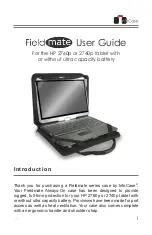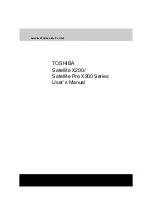
4-20 Hardware Functional Overview
The notebook uses the TEAC 24X-speed IDE CD-ROM Drive which reads
digital data stored on the CD-ROM at a rotational speed which is 24 times
faster. The CD-ROM drive supports CD-DA transfer over ATAPI function that
the host system can read CD audio data. The drive also supports Photo-CD
Multi-session disc compatibility and Multimedia PC-3 specification
compatibility.
Power Subsystem
The Power Subsystem consists of the following major sections:
AC Power Adapter
The computer is equipped with a 50W universal AC power adapter that converts
AC voltage (100 to 240VAC, 47 to 63Hz) into DC voltage which is used to
operate the notebook and charge the batteries.
Internal Battery Pack
When the AC Adapter is not connected to the computer, the computer utilizes
Lithium-Ion (Li-Ion) which provides DC power for the notebook and the real
time clock battery.
The normal charging time for the Li-Ion battery is approximately 2.5 hours
when computer is turned off, and 8 hours when the computer is running.
Running time of battery is approximately 2 to 2.5 hours.
DC-DC Module of Motherboard
The DC-DC module receives approximately 12VDC from the battery pack and
uses this input voltage to generate multiple regulated output voltages to provide
power for all internal notebook board assemblies.
LCD Inverter Board Assembly
The LCD Inverter Board Assembly is located in the LCD Panel Assembly. It
converts the +12VDC input directly from the Battery Pack into a high voltage
AC output which is used to light the CCFT (Cold-Cathode Fluorescent Tube).
Micro-P Subsystem (PIC-16C62)
The micro controller PIC16C62 acts as a supplement for the power management
control. It supports many functions via the SMBus interface.
The system communicates with the PIC16C62 via the SMBus interface. The
SMBus host (M38867) should first be initialized before starting the transaction.
The following is the procedure used for system communication with PIC16C62:
1.
Enable SMBus interface by writing 01h to SmbHstCfg register.
2.
Get SMBus I/O port base address by reading from SmbBA register.
















































